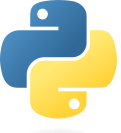
Back Python (programmeertaal) Afrikaans Python (Programmiersprache) ALS Python AN بايثون (لغة برمجة) Arabic পাইথন Assamese Python AST Python (proqramlaşdırma dili) Azerbaijani پایتون AZB Python BAN Python (мова праграмавання) Byelorussian
Python is a programming language. It was made to be open source and easy to read. A Dutch programmer named Guido van Rossum made Python in 1991. He named it after the television program Monty Python's Flying Circus. Many Python examples and tutorials include jokes from the show.[31]
Python is an interpreted language. Interpreted languages do not need to be compiled to run. A program called an interpreter runs Python code on almost any kind of computer. This means that a programmer can change the code and quickly see the results. This also means Python is slower than a compiled language like C, because it is not turned into machine code ahead of time. Instead, this happens as the program is running.
Python's developers try to avoid changing the language to make it better until they have a lot of things to change. Also, they try not to make small repairs, called patches, to unimportant parts of CPython, the main version of Python, even if the patches would make it faster. When speed is important, a Python programmer can write some of the program in a different language, like C, or use PyPy, a different kind of Python that uses a just-in-time compiler.
Keeping Python fun to use is an important goal of Python’s developers. It reflects in the language's name, a tribute to the British comedy group Monty Python. Tutorials often take a playful approach, such as referring to spam and eggs instead of the standard foo and bar.
- ↑ "General Python FAQ — Python 3.9.2 documentation". docs.python.org. Archived from the original on 24 October 2012. Retrieved 2021-03-28.
- ↑ "Python 0.9.1 part 01/21". alt.sources archives. Archived from the original on 11 August 2021. Retrieved 2021-08-11.
- ↑ "Python 3.12.5 released". 7 August 2024. Retrieved 7 August 2024.
- ↑ "Why is Python a dynamic language and also a strongly typed language - Python Wiki". wiki.python.org. Archived from the original on 14 March 2021. Retrieved 2021-01-27.
- ↑ "PEP 483 -- The Theory of Type Hints". Python.org. Archived from the original on 14 June 2020. Retrieved 14 June 2018.
- ↑ "Download Python". Python.org. Archived from the original on 8 August 2018. Retrieved 2021-05-24.
- ↑ File extension .pyo was removed in Python 3.5. See PEP 0488 Archived 1 June 2020 at the Wayback Machine
- ↑ Holth, Moore (30 March 2014). "PEP 0441 -- Improving Python ZIP Application Support". Archived from the original on 26 December 2018. Retrieved 12 November 2015.
- ↑ "Starlark Language". Archived from the original on 15 June 2020. Retrieved 25 May 2019.
- ↑ Cite error: The named reference
faq-createdwas used but no text was provided for refs named (see the help page). - ↑ "Ada 83 Reference Manual (raise statement)". Archived from the original on 22 October 2019. Retrieved 7 January 2020.
- ↑ Cite error: The named reference
98-interviewwas used but no text was provided for refs named (see the help page). - ↑ 13.0 13.1 "itertools — Functions creating iterators for efficient looping — Python 3.7.1 documentation". docs.python.org. Archived from the original on 14 June 2020. Retrieved 22 November 2016.
- ↑ Cite error: The named reference
AutoNT-1was used but no text was provided for refs named (see the help page). - ↑ 15.0 15.1 Cite error: The named reference
classmixwas used but no text was provided for refs named (see the help page). - ↑ Cite error: The named reference
effbot-call-by-objectwas used but no text was provided for refs named (see the help page). - ↑ Cite error: The named reference
AutoNT-2was used but no text was provided for refs named (see the help page). - ↑ Cite error: The named reference
AutoNT-3was used but no text was provided for refs named (see the help page). - ↑ Cite error: The named reference
AutoNT-4was used but no text was provided for refs named (see the help page). - ↑ Cite error: The named reference
AutoNT-5was used but no text was provided for refs named (see the help page). - ↑ Cite error: The named reference
AutoNT-6was used but no text was provided for refs named (see the help page). - ↑ "CoffeeScript". coffeescript.org. Archived from the original on 12 June 2020. Retrieved 3 July 2018.
- ↑ "The Genie Programming Language Tutorial". Archived from the original on 1 June 2020. Retrieved 28 February 2020.
- ↑ "Perl and Python influences in JavaScript". www.2ality.com. 24 February 2013. Archived from the original on 26 December 2018. Retrieved 15 May 2015.
- ↑ Rauschmayer, Axel. "Chapter 3: The Nature of JavaScript; Influences". O'Reilly, Speaking JavaScript. Archived from the original on 26 December 2018. Retrieved 15 May 2015.
- ↑ Cite error: The named reference
Juliawas used but no text was provided for refs named (see the help page). - ↑ Ring Team (4 December 2017). "Ring and other languages". ring-lang.net. ring-lang. Archived from the original on 25 December 2018. Retrieved 4 December 2017.
- ↑ Cite error: The named reference
biniwas used but no text was provided for refs named (see the help page). - ↑ Lattner, Chris (3 June 2014). "Chris Lattner's Homepage". Chris Lattner. Archived from the original on 25 December 2018. Retrieved 3 June 2014.
The Swift language is the product of tireless effort from a team of language experts, documentation gurus, compiler optimization ninjas, and an incredibly important internal dogfooding group who provided feedback to help refine and battle-test ideas. Of course, it also greatly benefited from the experiences hard-won by many other languages in the field, drawing ideas from Objective-C, Rust, Haskell, Ruby, Python, C#, CLU, and far too many others to list.
- ↑ "V Documentation". Retrieved 13 January 2024.
its design has also been influenced by Oberon, Rust, Swift, Kotlin, and Python.
- ↑ "Python Humor". Python.org. Retrieved 2020-09-19.
